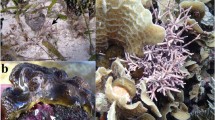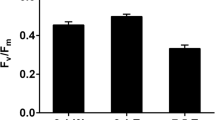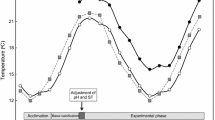Abstract
Coralline algae (CA), a type of primary calcifying producer presented in coastal ecosystems, are considered one of the highly sensitive organisms to marine environmental change. However, experimental studies on coralline algae responses to elevated seawater temperature and reduced pH have documented either contradictory or opposite results. In this study, we analysed the growth and physiological responses of coralline algae Porolithon onkodes to the elevated temperature (30.8°C) and reduced pH (7.8). The aim of this analysis was to observe the direct and combined effects, while elucidating the growth and photosynthesis in this response. It was demonstrated that the algae thallus growth rate and photosynthesis under elevated temperature were depressed by 21.5% and 14.9% respectively. High pCO2 enhanced the growth and photosynthesis of the thallus at ambient temperature, while they were deceased when both temperature and pCO2 were elevated. CA is among the most sensitive organisms to ocean acidification (OA) because of their precipitate high Mg-calcite. We hypothesize that coralline algae could increase their calcification rate in order to counteract the effects of moderate acidification, but offset by the effect of elevated temperature. Accordingly, our results also support the conclusion that global warming (GW) is a stronger threat to algal performance than OA. Our findings are also proposed that coralline algae may be more resilient under OA than GW.
Similar content being viewed by others
References
Anthony K R N, Kline D I, Diaz-Pulido G, et al. 2008. Ocean acidification causes bleaching and productivity loss in coral reef builders. Proceedings of the National Academy of Sciences of the United States of America, 105(45): 17442–17446, doi: 10.1073/pnas.0804478105
Bach L L, Freer J J, Kamenos N A. 2017. In situ response of tropical coralline algae to a novel thermal regime. Frontiers in Marine Science, 4: 212, doi: 10.3389/fmars.2017.00212
Blake C, Maggs C A. 2003. Comparative growth rates and internal banding periodicity of maerl species (Corallinales, Rhodo-phyta) from Northern Europe. Phycologia, 42(6): 606–612, doi: 10.2216/i0031-8884-42-6-606.1
Bopp L, Resplandy L, Orr J C, et al. 2013. Multiple stressors of ocean ecosystems in the 21st century: Projections with CMIP5 models. Biogeosciences, 10(10): 6225–6245, doi: 10.5194/bg-10-6225-2013
Burdett H L, Keddie V, MacArthur N, et al. 2014. Dynamic photoinhibition exhibited by red coralline algae in the Red Sea. BMC Plant Biology, 14:139, doi: 10.1186/1471-2229-14-139
Chisholm J R M. 2003. Primary productivity of reef-building crustose coralline algae. Limnology and Oceanography, 48(4): 1376–1387, doi: 10.4319/lo.2003.48.4.1376
Comeau S, Carpenter R C, Edmunds P J. 2014. Effects of irradiance on the response of the coral acropora pulchra and the calcifying alga hydrolithon reinboldii to temperature elevation and ocean acidification. Journal of Experimental Marine Biology and Ecology, 453: 28–35, doi: 10.1016/j.jembe.2013.12.013
Davies P S. 1989. Short-term growth measurements of corals using an accurate buoyant weighing technique. Marine Biology, 101(3): 389–395, doi: 10.1007/BF00428135
Diaz-Pulido G, Anthony K R N, Kline D I, et al. 2012. Interactions between ocean acidification and warming on the mortality and dissolution of coralline algae. Journal of Phycology, 48(1): 32–39, doi: 10.1111/j.1529-8817.2011.01084.X
Egilsdottir H, Noisette F, Noël L M L J, et al. 2013. Effects of pCO2 on physiology and skeletal mineralogy in a tidal pool coralline alga Corallina elongata. Marine Biology, 160(8): 2103–2112, doi: 10.1007/S00227-012-2090-7
Form A U, Riebeseil U. 2012. Acclimation to ocean acidification during long-term CO2 exposure in the cold-water coral lophelia pertusa. Global Change Biology, 18(3): 843–853, doi: 10.1111/j.1365-2486.2011.02583.X
Foster M S. 2001. Rhodoliths: Between rocks and soft places. Journal of Phycology, 37(5): 659–667, doi: 10.1046/j.1529-8817.2001.00195.x
Gao Kunshan, Zheng Yangqiao. 2010. Combined effects of ocean acidification and solar UV radiation on photosynthesis, growth, pigmentation and calcification of the coralline alga Corallina sessilis (Rhodophyta). Global Change Biology, 16(8): 2388–2398
Gattuso J P, Magnan A, Billé R, et al. 2015. Contrasting futures for ocean and society from different anthropogenic CO2 emissions scenarios. Science, 349(6243): aac4722, doi: 10.1126/science. aac4722
Glynn P W. 1996. Coral reef bleaching: Facts, hypotheses and implications. Global Change Biology, 2(6): 495–509, doi: 10.1111/j.1365-2486.1996.tb00063.x
Heyward A J, Negri A P. 1999. Natural inducers for coral larval metamorphosis. Coral Reefs, 18(3): 273–279, doi: 10.1007/s003380050193
Hoegh-Guldberg O, Mumby P J, Hooten A J, et al. 2007. Coral reefs under rapid climate change and ocean acidification. Science, 318(5857): 1737–1742, doi: 10.1126/science.H52509
Hofmann G E, Barry J P, Edmunds P J, et al. 2010. The effect of ocean acidification on calcifying organisms in marine ecosystems: An organism-to-ecosystem perspective. Annual Review of Ecology, Evolution, and Systematics, 41(1): 127–147, doi: 10.1146/annurev.ecolsys.110308.120227
Hofmann L C, Yildiz G, Hanelt D, et al. 2012. Physiological responses of the calcifying rhodophyte, Corallina officinalis (L.), to future CO2 levels. Marine Biology, 159(4): 783–792, doi: 10.1007/s00227-011-1854-9
Jiang Lei, Zhang Fang, Guo Minglan, et al. 2018. Increased temperature mitigates the effects of ocean acidification on the calcification of juvenile pocillopora damicornis, but at a cost. Coral Reefs, 37(1): 71–79, doi: 10.1007/s00338-017-1634-l
Johnson M D, Carpenter R C. 2012. Ocean acidification and warming decrease calcification in the crustose coralline alga Hydrolithon onkodes and increase susceptibility to grazing. Journal of Experimental Marine Biology and Ecology, 434–435: 94–101, doi: 10.1016/j.jembe.2012.08.005
Kim K, Portis A R Jr. 2004. Oxygen-dependent H2O2 production by Rubisco. FEBS Letters, 571(1-3): 124–128, doi: 10.1016/j.febslet.2004.06.064
Kroeker K J, Kordas R L, Crim R, et al. 2013. Impacts of ocean acidification on marine organisms: Quantifying sensitivities and interaction with warming. Global Change Biology, 19(6): 1884–1896, doi: 10.1111/gcb.l2179
Legrand E, Riera P, Lutier M, et al. 2017. Species interactions can shift the response of a maerl bed community to ocean acidification and warming. Biogeosciences, 14: 5359–5376, doi: 10.5194/bg-14-5359-2017
Lei Xinming, Huang Hui, Lian Jiansheng, et al. 2018. Community structure of coralline algae and its relationship with environment in Sanya reefs, China. Aquatic Ecosystem Health & Management, 21(1): 19–29
Li Xiubao, Liu Sheng, Huang Hui, et al. 2012. Coral bleaching caused by an abnormal water temperature rise at Luhuitou fringing reef, Sanya Bay, China. Aquatic Ecosystem Health & Management, 15(2): 227–233
Littler M M. 1973. The productivity of Hawaiian fringing-reef crustose corallinaceae and an experimental evaluation of production methodology. Limnology and Oceanography, 18(6): 946–952, doi: 10.4319/10.1973.18.6.0946
Martin S, Cohu S, Vignot C, et al. 2013. One-year experiment on the physiological response of the mediterranean crustose coralline alga, Lithophyllum cabiochae, to elevated pCO2 and temperature. Ecology and Evolution, 3(3): 676–693, doi: 10.1002/ece3.475
Martin S, Gattuso J P. 2009. Response of mediterranean coralline algae to ocean acidification and elevated temperature. Global Change Biology, 15(8): 2089–2100, doi: 10.1111/j.1365-2486.2009.01874.x
Martin S, Hall-Spencer J M. 2017. Effects of ocean warming and acidification on Rhodolith/Maërl beds. In: Riosmena-Rodriguez R, Nelson W, Aguirre J, eds. Rhodolith/Maërl Beds: A Global Perspective. Cham: Springer, 55–85
McCoy S J, Kamenos N A. 2015. Coralline algae (Rhodophyta) in a changing world: Integrating ecological, physiological, and geochemical responses to global change. Journal of Phycology, 51(1): 6–24, doi: 10.1111/jpy.l2262
Moenne A, González A, Sáez C A. 2016. Mechanisms of metal tolerance in marine macroalgae, with emphasis on copper tolerance in Chlorophyta and Rhodophyta. Aquatic Toxicology, 176: 30–37, doi: 10.1016/j.aquatox.2016.04.015
Morse J W, Andersson A J, Mackenzie F T. 2006. Initial responses of carbonate-rich shelf sediments to rising atmospheric pCO2 and “Ocean Acidification”: Role of high Mg-Calcites. Geochimica et Cosmochimica Acta, 70(23): 5814–5830, doi: 10.1016/j.gca.2006.08.017
Müller R, Desel C, Steinhoff F S, et al. 2012. UV-radiation and elevated temperatures induce formation of reactive oxygen species in gametophytes of cold-temperate/Arctic kelps (Laminariales, Phaeophyceae). Phycological Research, 60(1): 27–36, doi: 10.1111/j.1440-1835.2011.00630.x
Muñoz P T, Sáez C A, Martínez-Callejas M B, et al. 2018. Short-term interactive effects of increased temperatures and acidification on the calcifying macroalgae Lithothamnion crispatum and Sonderophycus capensis. Aquatic Botany, 148: 46–52, doi: 10.1016/j.aquabot.2018.04.008
Nash M C, Martin S, Gattuso J P. 2016. Mineralogical response of the mediterranean crustose coralline alga Lithophyllum cabiochae to near-future ocean acidification and warming. Biogeosciences, 13(21): 5937–5945, doi: 10.5194/bg-13-5937-2016
Nash M C, Uthicke S, Negri A P, et al. 2015. Ocean acidification does not affect magnesium composition or dolomite formation in living crustose coralline algae, Porolithon onkodes in an expertmental system. Biogeosciences, 12(17): 5247–5260, doi: 10.5194/bg-12-5247-2015
Nelson W A. 2009. Calcified macroalgae-Critical to coastal ecosystems and vulnerable to change: A review. Marine and Freshwater Research, 60(8): 787–801, doi: 10.1071/MF08335
Noisette F, Egilsdottir H, Davoult D, et al. 2013. Physiological responses of three temperate coralline algae from contrasting habitats to near-future ocean acidification. Journal of Experimental Marine Biology and Ecology, 448: 179–187, doi: 10.1016/j.jembe.2013.07.006
Perry C T, Hepburn L J. 2008. Syn-depositional alteration of coral reef framework through bioerosion, encrustation and cementation: taphonomic signatures of reef accretion and reef depositional events. Earth-Science Reviews, 86(1-4): 106–144, doi: 10.1016/j.earscirev.2007.08.006
Pospíšil P. 2016. Production of reactive oxygen species by photosystem II as a response to light and temperature stress. Frontiers in Plant Science, 7:1950
Quinn G P, Keough M J. 2002. Experimental Design and Data Analysis for Biologists. New York: Cambridge University Press
Ragazzola F, Foster L C, Form A, et al. 2012. Ocean acidification weakens the structural integrity of coralline algae. Global Change Biology, 18(9): 2804–2812, doi: 10.1111/j.1365-2486.2012.02756.x
Riebesell U, Zondervan I, Rost B, et al. 2000. Reduced calcification of marine plankton in response to increased atmospheric CO2. Nature, 407(6802): 364–367, doi: 10.1038/35030078
Schemer F, Pereira C M, Duarte G, et al. 2016. Effects of ocean acidification and temperature increases on the photosynthesis of tropical reef calcified macroalgae. PLoS One, 11(5): e0154844, doi:10.1371/journal.pone.0154844
Semesi I S, Kangwe J, Björk M. 2009. Alterations in seawater pH and CO2 affect calcification and photosynthesis in the tropical coralline alga, Hydrolithon sp. (Rhodophyta). Estuarine, Coastal and Shelf Science, 84(3): 337–341, doi: 10.1016/j.ecss.2009.03.038
Steiler D L, Riosmena-Rodriguez R, Foster M S, et al. 2003. Rhodolith bed diversity in the Gulf of California: The importance of rhodolith structure and consequences of disturbance. Aquatic Conservation: Marine and Freshwater Ecosystems, 13(S1): S5–S20, doi: 10.1002/aqc.564
Vásquez-Elizondo R M, Enríquez S. 2016. Coralline algal physiology is more adversely affected by elevated temperature than reduced pH. Scientific Reports, 6: 19030, doi: 10.1038/srepl9030
Zhang Chenglong, Huang Hui, Ye Cheng, et al. 2013. Diurnal and seasonal variations of carbonate system parameters on Luhuit-ou fringing reef, Sanya Bay, Hainan Island, South China Sea. Deep Sea Research Part II: Topical Studies in Oceanography, 96: 65–74, doi: 10.1016/j.dsr2.2013.02.013
Author information
Authors and Affiliations
Corresponding author
Additional information
Foundation item: The National Natural Science Foundation of China (NSFC) under contract Nos 41306144 and 41676150; the National Key Research and Development Plan under contract No. 2017YFC0506301; the Strategic Priority Research Program of the Chinese Academy of Sciences under contract No. XDA13020402; the Guangdong Basic and Applied Basic Research Foundation under contract No. 2019A1515011532.
Rights and permissions
About this article
Cite this article
Lei, X., Jiang, L., Zhang, Y. et al. Response of coralline algae Porolithon onkodes to elevated seawater temperature and reduced pH. Acta Oceanol. Sin. 39, 132–137 (2020). https://doi.org/10.1007/s13131-020-1548-6
Received:
Accepted:
Published:
Issue Date:
DOI: https://doi.org/10.1007/s13131-020-1548-6




